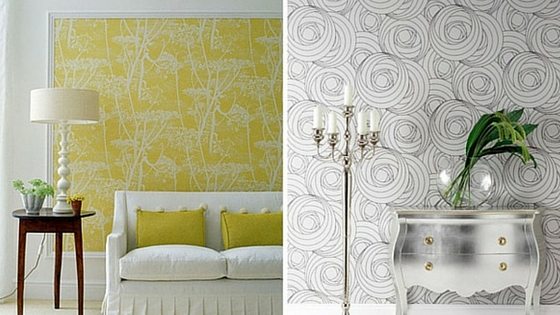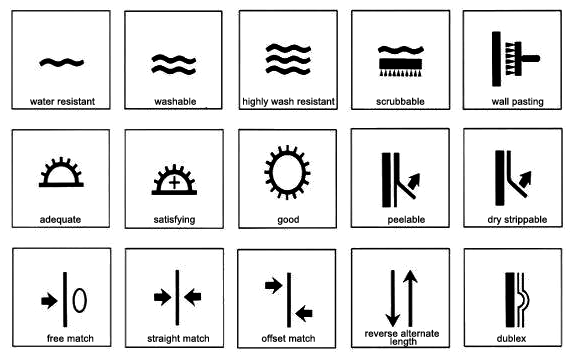Wallpaper is definitely back in style! Although there may have been some scarring experiences surrounding wallpaper, it is no longer a troublesome task to undertake. Manufacturers have come a long way in updating the style and product material to suit any design.
Wallpaper unfortunately often still has a negative connotation with it, but the industry has vastly improved in areas of design and production. The papers are far easier to work with and designs are no longer limited. There are innovative wallpaper products and a variety of papers suited for different purposes; bathroom specific wallpapers for instance.
If you’ve ever looked on the back of a wallpaper sample page, you probably noticed all the information and details that accompany that paper. While these can be extensive and feel like technical jargon, most of the information there is to help you to make the process of wallpapering simpler. Wallpaper pages typically list a legend on the back, similar to your clothing tags with washing instructions that inform you on the attributes of that paper.
Wallpaper Symbols
The symbols that appear on the back of a wallpaper page should tell you if it’s washable or scrubbable. Some are only spongeable, generally papers with fabric a 3D element of some sort, such as velvet. The legend also indicates if it is peelable versus strippable. Peelable refers to a paper that will peel off the wall, but will leave a layer behind that can be taken off when sponged with warm water/or steamed. Strippable on the other hand, means the paper will come off in one clean piece. Lastly, the pages should also specify if the paper is pre-pasted or unpasted. Every manufacturer has a different approach to labeling this information. If you’re lucky you’ll find a book that has a printed description under each symbol to clarify what the symbol means. This isn’t always the case and often they will list solely the printed description or symbol characters. Here’s/Below a reference to the common symbols found on the back of wallpaper pages.
Installation
There are two ways to go about installing wallpaper, whether you’re doing it yourself or hiring a professional, wallpapers come either Pre-pasted or Un-pasted. Don’t limit yourself by eliminating one method altogether. Wallpapers are not categorized in any way by the method of how they’re installed; each wallpaper within one wallpaper book could be a culmination of both.
Pre-pasted papers have an adhesive included on the back of the paper, which is activated by running the paper through water. A luke warm temperature of water is ideal to submerge the roll. In addition, pre-pasted requires the booking method before you can apply it to the wall. This just means that after you’ve run it through water, you fold the ends into the middle without creasing the folds to let the adhesive that’s being activated to simulate. This prevents it from contracting or expanding on the wall.
Unpasted requires applying a paste to the wall or possibly the back of the paper and then applying the strip to the wall. With papers that require paste, it’s not necessary to book the paper before applying like the pre-pasted. Typically unpasted papers require the wall to be pasted, however there are papers that necessitate pasting the back of the paper. Be sure to read the wallpaper instructions, and your manufacturers’ guidelines for the paper you’re working with to achieve the best outcome.
Opinions differ on which method is easier, which is why neither is better or worse than the other. They both have their advantages and limitations. For instance, pre-pasted requires running the paper through water then applying which could be messier to deal with than a solid paste already on the wall. On the other hand, the paste is an added expense and involves an additional step in the process.
Application
The most difficult part about applying wallpaper, is typically the first strip. It’s recommended to start on the least noticeable corner, such as the wall that the entrance door belongs to. Once you’ve lined up the first strip completely plumb, it’s a breeze to continue the remaining strips and know that they are following a level, straight line.
Wallpapering is the perfect project for the age of DIY’ers. While I’d consider hiring an installer for fine wallcoverings, the task itself is far easier to undertake than you’d expect. It’s an affordable solution to some of the more expensive finishing techniques available, and has a higher level of impact than paint alone can achieve.
Stay tuned for our next blog as we explore wallpaper colours, patterns and design!
Check Out Creative Haus Designs At The Paint People For More Decor Ideas!




[…] that you have a better understanding of how to look for wallpaper (Choosing the Right Wallpaper Part I) it all comes down to implementing it to suit your home. Gone are the days where you would […]